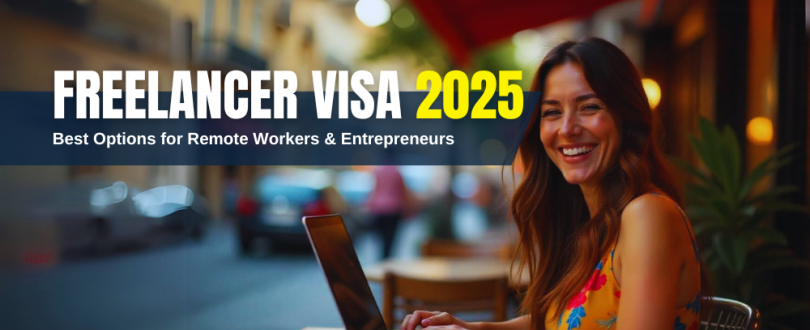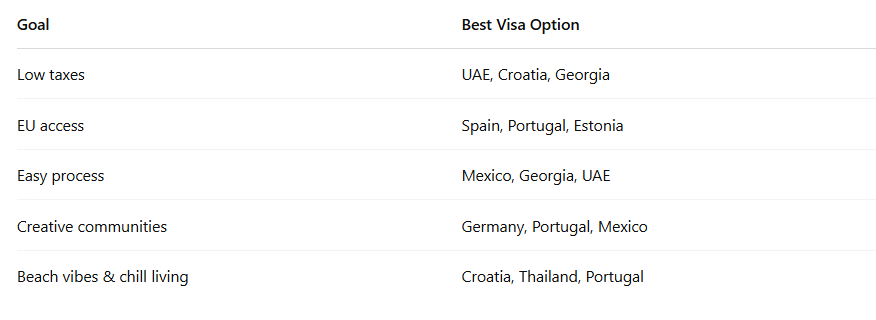
Let’s be honest: remote work is no longer just a trend—it’s a full-on lifestyle. Whether you’re a web developer in Bali, a writer bouncing between European cities, or an online coach working from a quiet beach town in Mexico, location freedom is the new career flex.
But there’s a catch. Just because you can work from anywhere doesn’t mean you legally should without the right visa. Tourist visas aren’t designed for working (even online), and overstaying or working under the radar can mess up future travel plans. That’s where freelancer and digital nomad visas come in.
If you’re planning your next move in 2025 and want to do things legit, here’s a breakdown of the best freelancer visa options out there—plus what to expect, how to qualify, and what makes each country appealing.
What is a Freelancer or Digital Nomad Visa, Exactly?
A freelancer visa (sometimes called a digital nomad visa) is a residency permit that lets you live in a country while working remotely—usually for foreign clients or companies. You’re not taking local jobs; you’re bringing income from outside, and in return, you get legal status, peace of mind, and often access to public services or tax breaks.
Key Things to Look For in a Freelancer Visa
Before diving into the countries, here are a few things you’ll want to consider:
– Minimum Income Requirements: Most visas require proof you’re earning enough to support yourself. This ranges from $1,000 to $7,000/month.
– Visa Length & Renewal: Some are valid for 6 months, others for 1–2 years, with potential extensions.
– Tax Implications: Some countries offer tax exemptions, while others will want a slice of your global income.
– Health Insurance: Many require international or local health coverage.
– Application Process: Paperwork-heavy or smooth online portals? This can vary a lot.

Top Freelancer Visa Options for 2025
Let’s break down the best options right now, with pros, cons, and real-world considerations.
1. Spain – Digital Nomad Visa (Launched 2023, Still Hot in 2025)
– Minimum income: ~€2,650/month (or €31,920/year)
– Visa length: 1 year, renewable up to 5 years
– Taxes: Discounted rate (15%) for the first 4 years
– Family allowed: Yes
– Application: Online or in-country
Why it’s a top pick: Spain finally jumped into the digital nomad visa game and did it well. You get to live legally in places like Barcelona, Valencia, or the Canary Islands, enjoy great healthcare, and pay less tax than locals (at least at first). Plus, the lifestyle here? Sunshine, fast internet, low cost of living—it checks a lot of boxes.
Heads up: The bureaucracy can be slow. And you can’t be employed by more than 20% Spanish clients if you’re freelancing locally.
2. Portugal – D7 Visa & New Digital Nomad Visa
– Minimum income: Around €3,040/month for digital nomad visa
– Visa length: 1 year, renewable
– Taxes: NHR (Non-Habitual Resident) tax scheme may apply
– Family allowed: Yes
– Application: Apply from your home country
Why it’s great: Portugal has been a remote worker favorite for years, and now they’ve streamlined options even more. You’ve got cozy beach towns, Lisbon’s tech scene, and a welcoming expat community. If you prefer a more passive-income setup, the D7 visa might be better, but the digital nomad visa is tailored to freelancers.
Watch out for: Rising housing costs in Lisbon and Porto. Consider smaller towns or islands like Madeira.
3. Estonia – Digital Nomad Visa Pioneer
– Minimum income: €4,500/month (gross)
– Visa length: 1 year (no renewal, but bridge to residency possible)
– Taxes: You’ll pay Estonian taxes if you stay over 183 days
– Application: Online or at an embassy
Why it’s worth a look: Estonia was the first country to launch a proper digital nomad visa back in 2020. They’ve got tech-forward services, fast internet, and a strong startup vibe. It’s ideal if you want to plug into a Baltic/European hub that’s still under the radar.
Reality check: Winters are dark and cold. And the income requirement is on the higher end.
4. Croatia – Digital Nomad Residence Permit
– Minimum income: Around €2,540/month (plus extra for dependents)
– Visa length: Up to 1 year (non-renewable, but you can reapply)
– Taxes: Exempt from income tax
– Application: Online or in-person
What’s cool: Croatia is stunning—and it knows it. Cities like Split, Dubrovnik, and Zagreb are remote work-friendly, and this visa gives you full legal status without taxing your global income. English is widely spoken, and cost of living is reasonable outside peak summer.
The fine print: Healthcare insurance and background checks are required, and you can’t stay beyond the one-year limit unless you leave and reapply.
5. Mexico – Temporary Resident Visa for Freelancers
– Minimum income: ~$2,600/month (or $43,000 in savings)
– Visa length: 1 year, extendable up to 4 years
– Taxes: You may owe tax if you stay over 183 days
– Application: At a Mexican consulate abroad
Why it works: Mexico doesn’t have a digital nomad visa per se, but the temporary resident visa is a great workaround. Cities like Mexico City, Oaxaca, and Mérida are digital nomad hubs for a reason—low cost of living, great food, solid coworking, and a creative vibe.
Pro tip: Some consulates are stricter than others. It pays to shop around.
6. Georgia – Remotely From Georgia Program
– Minimum income: ~$2,000/month
– Visa length: 1 year
– Taxes: Not taxed if you stay under 183 days
– Application: Easy online form
Why it’s underrated: Georgia (the country, not the state) offers big benefits with minimal red tape. You can stay up to a year visa-free from many countries, and the official digital nomad program just makes it even smoother. Tbilisi has great cafés, fast internet, and a ridiculously low cost of living.
Downsides: It’s still developing in some ways, and English isn’t as widespread outside of cities.
7. Dubai (UAE) – Virtual Working Program
– Minimum income: $3,500/month
– Visa length: 1 year
– Taxes: No personal income tax
– Application: Online, quick turnaround
Why consider it: Dubai offers something totally different—modern infrastructure, year-round sun, and global connectivity. If you’re building a business or doing remote work with higher income, the zero-tax setup can be a serious win.
Keep in mind: It’s not cheap. Rent, food, and entertainment come at a premium.
Honorable Mentions (Still Worth Exploring)
Germany – Freelancer Visa (“Freiberufler”): Great for creatives, especially in Berlin, but it’s paperwork-heavy.
Thailand – Long-Term Resident (LTR) Visa: Aimed more at high earners ($80K+/year), but a beautiful long-stay option.
Greece – Digital Nomad Visa: Attractive if you want island life and a low tax deal (50% income tax exemption).

Which Freelancer Visa is Right for You?
It depends on your priorities. Ask yourself:
– Are you looking for low cost of living, or are you okay spending more for high-end infrastructure?
– Do you want to be in Europe, Latin America, or somewhere totally different?
– How important is tax structure, visa length, or bringing family with you?
Here’s a quick cheat sheet:

Final Tips for 2025
– Always double-check requirements. These programs change, and what worked last year might be different now.
– Don’t rely on tourist visas. It’s tempting, but risky.
– Set up international health insurance. Some countries won’t approve your visa without it.
– Have clean finances and a stable income. It makes everything smoother.
– Plan at least 2–3 months ahead. Bureaucracy takes time.
Bottom Line
Freelancer visas in 2025 are better than ever. Countries are competing to attract remote workers, and that means more choices, clearer paths, and in some cases—really sweet tax deals. Whether you’re just starting out as a freelancer or running a full-blown business remotely, picking the right visa can help you live, work, and explore legally and stress-free.
So yeah, the world really is your office. Just make sure your paperwork is as on point as your Wi-Fi.
Want help choosing the right country for your freelancing lifestyle? Drop your goals and preferences in the comments—we’ll help you narrow it down.

